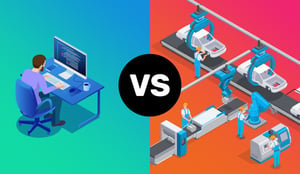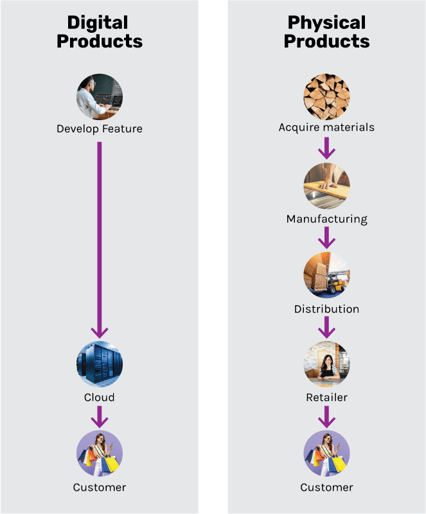 Product roadmaps are not a new idea, but how we develop, follow, and manage roadmaps is changing. Every company needs to have sleek, powerful software that allows agility, oversight, and transparency for product management to stay competitive. Your product managers deserve to have powerful tools geared towards their responsibilities, allowing them to use one software for everything, rather than piecing together reports, data, emails, and presentations with multiple programs.
Product roadmaps are not a new idea, but how we develop, follow, and manage roadmaps is changing. Every company needs to have sleek, powerful software that allows agility, oversight, and transparency for product management to stay competitive. Your product managers deserve to have powerful tools geared towards their responsibilities, allowing them to use one software for everything, rather than piecing together reports, data, emails, and presentations with multiple programs.
Thousands of companies produce products every day, from digital to physical products, to complex industrial products. While all of these companies need roadmaps to create, build, and launch their products, the needs of their managers are different. Let's look at physical product manufacturers and digital product creators and how their needs differ.
Factor One: Timelines
Establishing a Timeline for a Digital Product
 Digital products, by nature, are faster to create. When everything is online, the process can be fairly streamlined as long as the manager has developed an effective roadmap and is managing it appropriately. Communication remains essential; however, the milestones can be spaced relatively close together, often with as few as weeks or months between them.
Digital products, by nature, are faster to create. When everything is online, the process can be fairly streamlined as long as the manager has developed an effective roadmap and is managing it appropriately. Communication remains essential; however, the milestones can be spaced relatively close together, often with as few as weeks or months between them.
Deploying a digital product to get beta-customer feedback can happen on a quick-paced timeline. New software can be created and released in months or even a year or two. New integrations or features can also be released quickly and efficiently.
Digital product planning operates on a much more condensed roadmapping strategy than physical products. When supply chains run into problems and resources are in flux, digital products can carry on as usual because they are based online. In contrast, physical products must rely on available materials to be created.
Developing Timelines for Complex Physical Products
There is no such thing as an impactful three-month roadmap for a complex physical product, especially in the automotive, industrial, or consumer electronic sectors. When we're talking about roadmaps for physical products, we envision 3-year, 6-year, and long-term planning.
Within the overarching roadmap for physical products, each department will often have highly-specific milestones. Your engineering team will have milestones that keep them on track as they develop the possible architecture of the product. Your design team will also have milestones for their goals. Each step of the manufacturing and integration process will also require a detailed roadmap, so every important stage is documented and scheduled. The product manager is in charge of ensuring all these timelines are met in tandem with the primary roadmap.

Factor Two: Product Strategy
Both physical and digital products require product strategies if a company ever wants to be successful. This involves knowing what problem their product solves for the customer, detailed analysis of who the target market is, awareness of what the competition is doing, and clear goals for the product.
Experimentation and Market Testing - Digital Products
 When it comes to experimenting with new features and testing the market, digital products can accomplish these in less time than physical products can. A software company can release a new feature or a new design to a select handful of beta users and collect real-time data from them as they use it. They can also collect their feedback on the experience before launching the new settings to everyone in the product.
When it comes to experimenting with new features and testing the market, digital products can accomplish these in less time than physical products can. A software company can release a new feature or a new design to a select handful of beta users and collect real-time data from them as they use it. They can also collect their feedback on the experience before launching the new settings to everyone in the product.
If you've ever used software or an app, the chances are high that you've at least received an offer to test a feature. Your participation allows the company to make changes and fine-tune the less popular parts. That way, when the company releases the new version, they know they've already tested the market.
Experimentation and Market Testing - Physical Products
With physical products, there is still a period of experimenting with new features or designs and testing them out with users. The testing process also takes a bit longer for physical products. Since a digital product can be shared almost instantly and a physical product either requires being delivered into the hands of consumers or bringing consumers into a company location to test the product, more logistics and time is involved.
Physical products may not introduce sweeping changes to their products as frequently as digital ones do, but the research and testing phase is equally as important. Some may argue vetting an idea for a physical product is more critical because the potential to lose volumes of money on a bad idea is higher for a physical product than it is for a digital one.
Responding to the Market for Physical Products
Market changes influence physical products. An experienced product manager will know their products inside and out and monitor the trends of the target audience. They will complete extensive research to inform product development decisions to ensure the company is releasing products customers want and need. But in some situations, world trends bring unexpected swings in preferences or attitudes that will have unpredictable impacts on a product.
When the unpredictable happens, product managers need to be able to make decisions with agility. Having oversight of all product lines can provide the opportunity to save a launch, as long as it still matches the vision for the product. For example, a specific type of battery might be in short supply due to a conflict in the region where the resources are found to make the batteries. A different battery can be sourced as a replacement either from an external source or from another product, but this can only work if the battery does not reduce the profitability or selling factor of the product.
Making Tough Decisions Based on Data

Sometimes a component is impossible to acquire and is also the value proposition of the product. For example, an eco-friendly phone with a solar-powered battery has a selling factor of using solar power. If that solar-powered battery cannot be procured on the established timeline, the product manager will need to make the decision to delay the release because a generic substitution will not match the target market.
Swapping out parts is not always an option, but a product manager won't be able to make that decision unless they have a strong product strategy and an overview of all roadmaps.
Factor Three: Oversight and Transparency
To make important decisions regarding products and their roadmaps, product managers and their support teams need to have oversight of all the moving players in the field. Product managers need to examine the product vision and decide whether a change in scope will impact the business's growth or the market share for that particular product line. Is it worth it to the company to keep a timeline of the value of the product will decrease? Having a virtual space or dashboard that focuses on those high-level details and stats allows managers and stakeholders o make quicker, accurate decisions.
As a product manager, your concern is what value the customer will realize and when—nothing else. So if things get delayed, you are not interested in tasks or detail of project management. Instead, you want to know the impact of a module or component delay on your product portfolio realizing its value; if you can change the scope of the product and keep the date, how would that impact the growth of your business/product line market share. A dashboard/virtual space that focuses on that and allows stakeholders to focus on that can make a difference in making faster/better decisions.
A Product Roadmap For Physical Products Needs the Right Software
Gocious is the software that gives product managers the tools they need for high-level oversight of all their product roadmaps. We make collaboration, communication, analysis and decision-making more accessible than ever. There is customization throughout the software, so you can track the metrics that reflect the highest value and cut out the background noise. Book your free demonstration with us to find out how.



